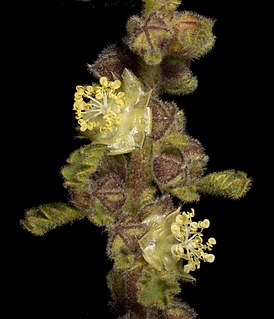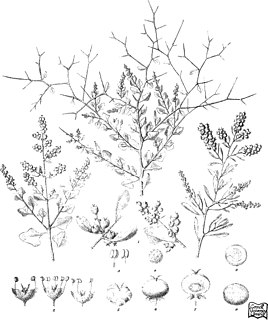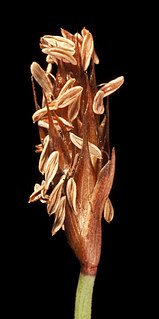
Ptilotus R.Br. is a genus of approximately 120 species of annual and perennial herbs and shrubs in the family Amaranthaceae. All species are native to mainland Australia, although one species, Ptilotus spathulatus (R.Br.) Poir., also occurs in Tasmania and another, Ptilotus conicus R.Br., in Malesia on the islands of Flores and Timor. Most of the diversity is in Western Australia, particularly in the Pilbara. Common names for species in this genus include mulla mulla, foxtails, pussy tails and lamb's tails. The genus was first formally described by botanist Robert Brown in Prodromus Florae Novae Hollandiae in 1810. In family-level phylogenetic studies, Ptilotus has been placed within a clade informally known as the 'aervoids'. It has been resolved as monophyletic and is closely related to Aerva Forssk. An interactive key to the species of Ptilotus is available at KeyBase.

Suaeda australis, the austral seablite, is a species of plant in the family Amaranthaceae, native to Australia. It grows to between 0.1 and 0.9 metres in height, with a spreading habit and branching occurring from the base. The leaves are up to 40 mm in length and are succulent, linear and flattened. They are light green to purplish-red in colour.

Thysanotus patersonii, the twining fringe-lily, is a climbing perennial herb which is endemic to Australia.

Ficus fraseri, the white sandpaper fig or shiny sandpaper fig, is one of several fig species commonly known as sandpaper figs. It is native to New South Wales, Queensland and the Northern Territory in Australia and to New Caledonia and Vanuatu. Other common names are "figwood" and "watery fig".

Stypandra glauca is a species of rhizomatous perennial plant. It is widespread across southern areas of Australia, where it is informally known as the nodding blue lily or blind grass.
Plantago debilis is a species of herb native to Australia. Common names include shade plantain and weak plantain.

Lambertia inermis, Noongar chittick, is a shrub which is endemic to south-west Western Australia. It grows to 6 metres high and flowers from spring to winter. A more complete description is given in Florabase and Australian Flora online.

Haemodorum brevicaule is a perennial herb from 0.025 to 0.3 m tall, in the bloodroot family, the Haemodoraceae, native to northern Australia. It has deep-red to purplish-black flowers which are seen from September to December, and it grows on red clay and basalt.

Velleia paradoxa, or spur velleia, is a small, softly pubescent perennial herb in the family Goodeniaceae, endemic to Australia. It is found in South Australia, Tasmania, Victoria, New South Wales and southern Queensland. It grows in sclerophyll forest and grassland. It has oval to elliptical leaves which are from 7–25 centimetres (3–10 in) long and it flowers mainly from August to February.

Velleia lyrata is a small perennial herb in the family Goodeniaceae, endemic to Australia. It is found mainly near Sydney, but also near the NSW and Queensland border, and in Queensland. A map of its occurrence records is given here. It grows in damp situations in heath on sandy soils. The cordate base to the adaxial sepal is a feature distinguishing it from many other Velleias. A full description of the plant is given in Flora of Australia online.
The Australasian Virtual Herbarium (AVH) is an online resource that allows access to plant specimen data held by various Australian and New Zealand herbaria. It is part of the Atlas of Living Australia (ALA), and was formed by the amalgamation of Australia's Virtual Herbarium and NZ Virtual Herbarium. As of 12 August 2014, more than five million specimens of the 8 million and upwards specimens available from participating institutions have been databased.

Lawrencia densiflora is a species of plant in the mallow family, Malvaceae. It is endemic to Western Australia

Lawrencia squamata is a species of plant in the mallow family, Malvaceae. It is endemic to Australia and occurs in all Australian states.

Chenopodium spinescens is a species of plant in the family Amaranthaceae, endemic to Australia. It is found in all states and territories of Australia with the exception of Tasmania.

Gynochthodes jasminoides is a woody climber or a scrambling shrub in the family Rubiaceae. In Australia it is found on the northern and eastern coasts, in Western Australia, the Northern Territory, Queensland, Victoria, and New South Wales.

Calandrinia granulifera is an annual herb in the family Montiaceae, and is native to New South Wales, Tasmania, Western Australia, South Australia, and Victoria.
Hakea oligoneura is a small rare shrub known from only a few populations south of Perth, Western Australia growing exclusively on coastal limestone ridges. It has cream-white flowers and stiff, thick yellow-greenish leaves.

Ptilotus schwartzii is a grass-like plant in the Amaranthaceae family.

Chordifex laxus is a rush species of the genus Chordifex in the family Restionaceae. It is endemic to the south-west of Western Australia.

Tribulus occidentalis, common name perennial caltrop, is a species of flowering plant in the family Zygophyllaceae, which is native to Australia, and found in Western Australia, Queensland, South Australia and the Northern Territory.

















